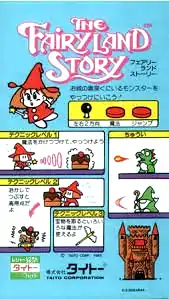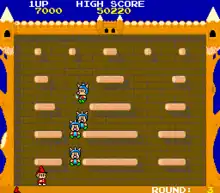The Fairyland Story
The Fairyland Story[lower-alpha 1] is a platform arcade game developed and published by Taito in 1985. In the game, the player controls the witch Ptolemy, with the objective being to clear the screen of all enemies. Ptolemy can use her wand to turn the enemies into large cakes, which she can then push off of platforms onto other enemies, which will squash them and award bonus points. Various Items that increase Ptolemy's projectile radius, as well as kill multiple enemies at the same time, will also appear throughout the stages.
| The Fairyland Story | |
|---|---|
 Arcade instruction card. | |
| Developer(s) | Taito |
| Publisher(s) | Taito |
| Designer(s) | Hiroshi Tsujino |
| Composer(s) | Tadashi Kimijima |
| Platform(s) | Arcade, Mobile phone, MSX, Nintendo Switch, PlayStation 4, X68000 |
| Release | |
| Genre(s) | Platform |
| Mode(s) | Single-player, multiplayer (alternating turns) |
Gameplay has often been compared to later Taito platform games, such as Bubble Bobble and The NewZealand Story. A Japanese MSX version developed and published by Hot-B was released in 1987, while a Sharp X68000 port was developed and published in 1991 by SPS. The Fairyland Story would be included in the arcade game collections Taito Legends 2, Taito Memories Jokan, Taito Memories Pocket, and Taito Legends Power-Up. A 2003 port for Japanese mobile phones was made available through the I-mode and EZweb network services. Around 2020, the game was later re-released on Nintendo Switch and PlayStation 4 via Arcade Archives.
Gameplay

The Fairyland Story is a platform arcade game. The player controls the witch Ptolemy through a series of single-screen stages, with the objective being to defeat all of the enemies on each screen. Ptolemy's main weapon is her projectile magic, which will temporarily transform the enemies into large cakes.[1] While in a "caked" form, the enemies can be destroyed either by further magic attacks or by being dropped off a platform, possibly squashing other enemies below.[1] Squashing more than one enemy results in an award of more points and, sometimes, in extra bonuses. 2000 points are awarded for squashing an enemy below a cake, with each additional enemy doubling the number of points awarded.[1] If two or more enemies are killed at once in one spot, a coin will appear in that spot, which may be collected for additional points, and if more are collected, will multiply in points, so as long the player doesn't lose a life.[1]
Ptolemy's enemies are based upon typical fantasy beings - these include Orcs,[2][3] pig-like soldiers, Salamanders,[2][3] dragon-like creatures that can breathe fire, Wizards,[2][3] mages that can make Ptolemy shrink and disappear, Clerics,[2][3] bishops who can multiply themselves, Golems,[2][3] and Wraiths,[2][3] hooded creatures can phase through Ptolemy's magic.[3][2] If Ptolemy takes too long to clear a level of a last remaining enemy, eventually that enemy will disappear without an award of points.[1] If, however, Ptolemy takes too long to clear more than one enemy from the level, a flying devil, named Horned,[2][3] appears to kill Ptolemy. The devil is invulnerable to Ptolemy's magic, and the only way to survive is for Ptolemy to kill all remaining enemies.[1]
Ptolemy's deaths are animated in different ways, depending on the enemy who kills her.[1][4] She can sometimes collect some utility bonuses which increase her power and range of her magic for a short while or offensive bonuses that, most usually, result in the cake-ification and destruction of all on-screen enemies.[2][3] At various intervals between levels, an intermission screen appears during the game showing Ptolemy riding on the back of a large, wingless blue dragon named Rodemy.[2] A message appears on each of these intermission screens, either congratulating the player or warning of some hazard in the next level.
Development and release
The Fairyland Story was released by Taito in Japan in July 1985[5] and in North America later that year. It was designed by Hiroshi "ONIJUST" Tsujino, best known for designing The Ninja Warriors, with music composed by Tadashi Kimijima.[6] While working at Taito's Yokohama Institute, Tsujino drafted an idea for a game where the player had to defeat enemies by crushing them under large cakes, which he claims to be partly inspired by his addiction to Namco's Dig Dug.[6] Early versions of the game were said to have been "monotonous" and left Tsujino largely unhappy with the outcome — being inspired by Broderbund's Lode Runner for the Apple II, he gave the game a larger emphasis on strategy and memorization, featuring reworked stage designs.[6] The game's final boss took a week to complete.[6] Executives at Taito were against the idea of the game having an ending and demanded that the team remove it, however Tsujino ignored their request.[6]
Conversions
An MSX port, developed and published by Hot-B, was released around 1987. This port featured new stages not found in the arcade version.[1] The port also featured two new enemies, the Iron Golem, which is the same as the Golem enemy but immune to Ptolemy's magic, and Fleck, an enemy that can use the same magic as Ptolemy.[1][2] Later, a Sharp X68000 port was developed and published by SPS, and was released around 1991.[1] Unlike the MSX port, however, this was a more straightforward port of the arcade version.[1] It added several features not found in the original arcade version, like level progress and high score saving, and the choice between two soundtracks, the choices being an emulation of the original soundtrack, or a remixed soundtrack.[1][3] In 2003, a port was made available for Japanese mobile phones via the I-mode and EZweb network services.[1] Not much information is known about this port besides some screenshots, and some of the music from this port appearing in a soundtrack album for mobile games made by Taito.[1] Emulated versions of the original arcade version would later be included on the arcade collections Taito Legends 2, Taito Memories Jokan, Taito Memories Pocket, and Taito Legends Power-Up.[1][7] On December 3, 2020, a port of the game was released worldwide on Nintendo Switch and PlayStation 4 as part of the Arcade Archives initiative by Hamster Corporation.[8] This port features online leaderboards and new gameplay modes.[8]
Reception and legacy
Retrospective views on The Fairyland Story have been mixed to positive. A mini review of the game in a The NewZealand Story retrospective in an issue of Retro Gamer claimed the game as "nothing special" due to its level designs and simplistic gameplay mechanics.[9] PlayStation Official Magazine - UK, while reviewing Taito Legends Power Up, unfavorably compared it to Parasol Stars, referring to it as a "dress rehearsal" for Parasol Stars.[10] However, it was praised for the fact that one could "turn the Pope into a muffin and push him off a ledge".[10] When criticizing the fact that Bubble Bobble was a locked game in Taito Memories Jokan, Hardcore Gamer said that while one could "make do" with it and Don Doko Don, ultimately stated that it was "decaf when you want espresso".[11] When reviewing Taito Legends 2, Eurogamer wrote that the game was "hugely additive", although criticized it for the lack of co-op play.[7] A more in-depth retrospective review on the game by Hardcore Gaming 101 was more positive, praising the game for its detailed graphics (for the time) and its risk-versus-reward gameplay elements.[1] While criticizing the game for being too punishing for beginner players, and for denying players the right to continue on rounds 99 through 101, ended that the game was "highly recommended" for people that are "into cute platformer games and/or Bubble Bobble-like games".[1] However, it was noted that the Sharp X68000 version was the best way to play the game, due to the addition of the save system, as well as the fact that it lets players continue anytime they liked.[1]
The Fairyland Story is often considered to be one of the spiritual predecessors to Bubble Bobble, mostly due to the similar gameplay mechanics.[1] Gameplay elements and power-ups from The Fairyland Story would later be used in The NewZealand Story.[4][9][12] A block formation that resembles Ptolemy appears as a hidden level in The NewZealand Story.[4][9][12] A hidden world in Rainbow Islands, called Magical Island, is based on The Fairyland Story.[1][4][13] The Worm enemy would later appear in both Don Doko Don and Don Doko Don 2.[14]
References
- Tursi, Lee (15 December 2019). "Fairyland Story, The". Hardcore Gaming 101. Archived from the original on 16 December 2019. Retrieved 16 December 2019.
- GA-Yume / HOTB (1987). The Fairyland Story manual (JP) (in Japanese).
- SPS (1991). The Fairyland Story (Sharp X68000) manual (in Japanese).
- Wheaton, Wil (11 September 2006). "Games of our Lives: The Fairyland Story". The A.V. Club. Archived from the original on 7 November 2019. Retrieved 26 September 2020.
- Akagi, Masumi (13 October 2006). タイトー (Taito). アーケードTVゲームリスト 国内•海外編 (1971-2005) (in Japanese) (1st ed.). Amusement News Agency. p. 42. ISBN 978-4990251215.
- "【第6回リレーブログ クリエーター編】"ニンジャウォリアーズ"辻野様". BEEP! (in Japanese). 29 October 2019. Archived from the original on 1 June 2019. Retrieved 26 October 2019.
- Reed, Kristan (2006-03-31). "Taito Legends 2". Eurogamer. Eurogamer.net. Archived from the original on 2 October 2019. Retrieved 2015-06-27.
- "PS4/Switch版「アーケードアーカイブス フェアリーランドストーリー」が12月3日に配信。敵をケーキに変身させる魔法を駆使してステージを攻略". 4Gamer (in Japanese). 2 December 2020. Archived from the original on 2 December 2020. Retrieved 29 December 2020.
- "Ultimate Guide: The New Zealand Story". Retro Gamer. 115: 58. 25 April 2013.
- "Taito Legends Power-Up Review". PlayStation Official Magazine – UK. 08: 87. December 2006.
- "Taito Memories Jokan Review". Hardcore Gamer. 1i4: 77. September 2005 – via Internet Archive.
- "The Ultimate Guide To The New Zealand Story". NowGamer. 10 January 2014. Archived from the original on 3 September 2018. Retrieved 24 September 2020.
- "The Definitive Bubble Bobble". Retro Gamer. 28: 59.
- Tursi, Lee (16 April 2020). "Don Doko Don 2". Hardcore Gaming 101. Archived from the original on 25 September 2020. Retrieved 25 September 2020.
External links
- The Fairyland Story at the International Arcade Museum
